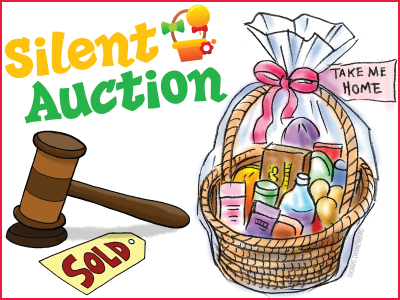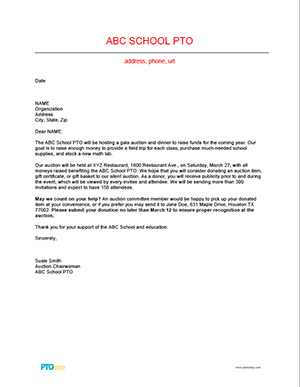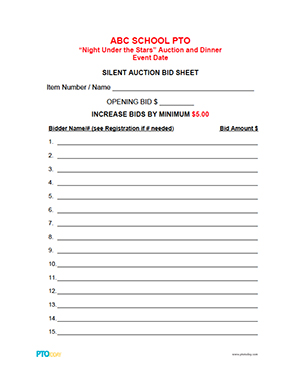School Auction Planning FAQs

Answers to key questions about organizing and running a successful school auction.
Our list of 21 frequently asked questions covers all stages of planning a school auction. Read through them all or skip to the section that you need most:
Advance Planning
Securing Donations
Event Preparation
Checkout
 Advance Planning
Advance Planning
-
How far in advance should we get started?
Form your planning committee and begin soliciting donations at least six months before your event. Announce the date about four months in advance, and distribute invitations about two months ahead of time. -
Can we combine an auction with our carnival or another PTO event?
You can, but consider this: Any auction, even a small one, is a fairly involved project. Pairing it with a family event such as a carnival can reduce the success of your auction. Bidders will get distracted if there are other activities going on, and precious volunteer resources will be stretched thin. -
If we have a good silent auction, do we need to have a live auction, too?
No. But a live auction adds an exciting component to the event and typically brings in the highest bids. For a live auction to be a success, you need very desirable items, generous bidders, and a skilled professional auctioneer. Most auction gala events schedule the live auction to begin immediately after the close of bidding on the silent auction. -
Do we need to charge for tickets?
That depends on the event format and community expectations. Guests typically purchase tickets for a sophisticated, adults-only auction gala in a community familiar with such fundraisers. If you are planning a standalone auction gala and charging for tickets, food is a must. (Providing hors d’oeuvres rather than a sit-down meal keeps guests circulating among—and bidding on—the auction items.) If the concept of an auction is new to your community, free or modestly priced admission would be more appropriate. Look around at similar events in your area to gauge what your community would accept. But don’t forget that an auction is first and foremost a fundraiser.
Join the PTO Today community (it's free) for access to resources, giveaways and more
-
Can our ticket price count as a charitable contribution for our guests?
Usually not since the buyer is receiving something of value for the ticket price: an evening out, food, entertainment, and so forth. (See IRS Publication 1771, Charitable Contributions—Substantiation and Disclosure Requirements, for more details.) -
Where should we have the event?
Some PTOs hold auctions in the school gym or cafeteria. The school is easy to access, usually free of charge to the PTO, and large enough to accommodate the event. However, the highest returns come when the event is moved off-campus to a more comfortable location, such as a social club, banquet hall, or community center. Whatever venue you choose, be sure it is close by, easy for guests to find, and able to support the requirements of your event. -
How should we advertise our event?
Use flyers, the school newsletter, school email broadcasts, bulletin boards, and any other normal PTO communication tool to promote your event. If you want to invite members of the greater community, consider placing an advertisement in the local newspaper and displaying posters around town. Announce the date and time up to four months in advance so people can mark their calendars, and continue with additional advertisements as the date draws nearer. -
Any other strategies for marketing the auction?
Build excitement about the event in the school community by talking about it often. Stress the benefits the auction could bring to the PTO and the students. Announce some of the most desirable auction items in advance and post photos of auction items in the newsletter or in a display case. Have a student contest to design the auction catalog cover. Hold a preview party for an especially large auction. Hold a drawing for free tickets. Set special pricing for early ticket sales. Adopt an event theme and logo and use it in all marketing materials. Involve students and teachers in creating some of the auction items.
 Securing Donations
Securing Donations
-
How do we solicit donations?
Assign one committee member to serve as donations manager, but have many people solicit the items. Beginning at least six months in advance, send letters of request to national organizations, taking care to abide by their corporate donations policies. Send letters to local and regional merchants, and follow-up with a personal phone call or face-to-face visit. Don’t forget parents and teachers; they often provide some of the best auction items. School families might donate personal items such as a weekend at their cottage or might have connections to businesses that would donate. Special one-of-a-kind art items made by students and teachers usually draw large bids. With your principal’s permission, each classroom can be assigned a theme to prepare a basket of items for the auction. Be creative. Start by reviewing our article on Finding Donations for Your Auction.Donation Request Template: Services or Money
Donation Request Template: Items or Products -
Do we need to have “big ticket” items?
Not necessarily, but it is wise to have a wide range of item values so all bidders can find something within their budget. Big-ticket items should be used as a draw in your advertising, though in the end, they may appeal to only a small number of your most generous bidders. Sometimes you can secure a valuable, appealing donation on consignment from a donor. The bidder pays the full amount of her winning bid, but your organization keeps only the amount over the consignment fee, called a “reserve.” Be careful about offering high-value items with many restrictions. The suite at a five-star resort is far less desirable if it can only be used Tuesday through Thursday in months that contain the letter “r.” -
Can we tell our donors their donation is tax-deductible?
Only if your PTO is registered as a tax-exempt charity with the IRS under section 501(c)(3) of the federal tax code. The IRS site has information on filing for tax exemption, and the PTO Today Startup Toolkit walks you through it step by step. -
What information do our donors need from us?
As far as the IRS is concerned, it is the donor’s responsibility to obtain a written acknowledgement of the donation. But you can assist your donors, and stay on their good sides, by providing a timely written thank-you. For tax purposes, your donors need in writing: the legal name of your PTO; a description (but not the value) of the item donated; and a statement that no goods or services were provided by the organization in exchange for the contribution. It is not necessary to provide the PTO’s employer identification number (sometimes called a tax ID) to the donor.
 Event Preparation
Event Preparation
-
What kind of data do we need to track for our auction?
You will need to manage four major types of data. First, you must track your guests. Second, you need a list of donors, including complete mailing addresses, to create thank-you letters and solicitation letters for future years. The third list is for donations. It helps keep track of the items during storage. Ultimately, some of the individual items will be bundled into packages for the auction; at that time, they should be assigned a new auction number. The fourth list contains the actual auction items, each numbered uniquely. -
Do we need to buy special software for our auction?
At minimum, the data should be kept on a computer spreadsheet system like Microsoft Excel. If your committee has the technical skills, a database like Microsoft Access is even better than spreadsheets. And some PTOs choose to purchase a professional auction software system. These systems do the setup work for you and can help make the whole process easier, but you still need to learn the system and enter the data. In any case, having the data on a computer allows you to create the auction catalog, bid sheets, donor thank-you letters, and post-auction analyses more efficiently and with less risk of typos or omissions. -
What information should go into our auction catalog?
The auction catalog should include: an introduction to your PTO; the benefits anticipated from the event’s proceeds; the event schedule; auction rules; an acknowledgement of donors, underwriters, and committee members; sponsor advertising; and most important, a description of each auction item, including auction number, value, and donor. The cover could feature the winning entry of a student art competition. Produce about two catalogs for every three guests. Make your catalog attractive and useful, but don’t invest too much on printing. They will all end up in the trash by night’s end. -
How long will it take to set up the auction room for a silent auction?
Plan to spend the entire day, with the aid of several helpers, moving the items from storage to the venue and setting up the items and displays. Stow any excess packaging under the display tables. Later, the winners can repackage their items for safe travel home. -
What information should be on the bid sheets for the silent auction?
The top of the sheet should include the auction item number, a description, the value, the donor, and any restrictions on the item. The middle area should include the minimum opening bid and the requested bid increment. Groups typically set opening bids as a percentage of the value of an item, such as 30 or 50 percent, and recommend bid increments of $1, $5, or $10, depending on the value of the item. Include at least 10 lines for guests to enter their name or bidder number and a bid amount. You can also have a section at the bottom of the bid sheet that is cut off to serve as a claim check when the buyer pays and needs to collect his item. Make sure your forms are easy to read even in dim lighting. When bidding closes and the runners remove the top bid sheet from the table, you need something left behind to identify the high bidder. An inexpensive method is to create a second page for each bid sheet where the runners write in the winning bidder number and high bid as soon as bidding closes. These sheets stay on display with the item while the cashiers process the original bid sheets. -
How do we close bidding?
First of all, train a few volunteers to be runners. The master of ceremonies should warn the guests and build excitement as the bidding time draws to a close. At the appointed time, the runners, each armed with a red pen, swarm the closed bid sheets. The runner circles the winning bidder/bid amount, removes the sheet from the table, and writes the winning bidder and bid amount on the second page of the bid sheet. The second page stays on the table so the guests can see who won the item. Runners deliver the original bid sheets to the cashiers, where they are consolidated by bidder and tallied for checkout.
 Checkout
Checkout
-
Should we accept credit cards?
Yes, if at all possible. Bidding increases when guests know they can pay by credit card. The benefit far outweighs the modest fee your PTO pays the credit card companies. Be sure to advertise in advance that credit cards will be accepted. Ideally, your PTO should have its own merchant account. Download the free Guide for PTOs and PTAs on Accepting Electronic Payments to find out what you need to know. -
How do we set up the checkout area?
Allow a generous workspace with good lighting for each cashier. Set up the tables near the auction displays, but in an uncrowded area. You’ll need three or four cashiers for a group of 100 to 150 guests. For each cashier, provide a cash box with change, credit card transaction forms, office supplies, a list of guest names with bidder numbers, and an auction catalog. All cashiers must have easy access to the completed bid sheets, so the cashiers can’t be spread too far apart. Encourage guests to approach any available cashier; setting up roped queue lines or alphabetic assignments isn’t as efficient. Checkout is the last impression your guests have of your PTO and the event, so you want it to go smoothly. -
How should we get the items to the winning bidder?
It is usually impractical and unnecessary to physically relocate or cordon off the auction items after bidding closes. For most PTO auctions, it is fine to leave the items on display until the winners claim them after paying. If an item has extreme value, such as a piece of jewelry, you might want to keep it at checkout. It is also a good idea to keep gift certificates at checkout so they don’t get mixed up with display props. These items should be given to the winner by the cashier. For all other items, provide a claim check to the buyer that lists their winnings. Runners floating around the silent auction area can assist guests with identifying items and packing up their winnings. Insist that all items be picked up at the conclusion of the event. You don’t want to be stuck delivering auction winnings all over town the next day.
Originally posted in 2008 and updated regularly


























